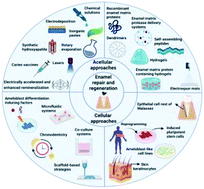Novel trends, challenges and new perspectives for enamel repair and regeneration to treat dental defects
Abstract
Dental enamel is the hardest tissue in the human body, providing external protection for the tooth against masticatory forces, temperature changes and chemical stimuli. Once enamel is damaged/altered by genetic defects, dental caries, trauma, and/or dental wear, it cannot repair itself due to the loss of enamel producing cells following the tooth eruption. The current restorative dental materials are unable to replicate physico-mechanical, esthetic features and crystal structures of the native enamel. Thus, development of alternative approaches to repair and regenerate enamel defects is much needed but remains challenging due to the structural and functional complexities involved. This review paper summarizes the clinical aspects to be taken into consideration for the development of optimal therapeutic approaches to tackle dental enamel defects. It also provides a comprehensive overview of the emerging acellular and cellular approaches proposed for enamel remineralization and regeneration. Acellular approaches aim to artificially synthesize or re-mineralize enamel, whereas cell-based strategies aim to mimic the natural process of enamel development given that epithelial cells can be stimulated to produce enamel postnatally during the adult life. The key issues and current challenges are also discussed here, along with new perspectives for future research to advance the field of regenerative dentistry.



 Please wait while we load your content...
Please wait while we load your content...